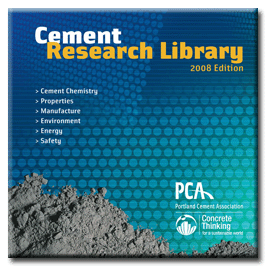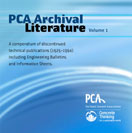 |
The vast majority of the papers in DVD025 were published or issued by the Portland Cement Association; a small number were written by PCA staff and published outside of PCA or in cooperation with other organizations.
- PCA Research Bulletins - selected cement-related reports from the LS, RX, DX, and RD series technical reports
- PCA R&D SN reports - selected published and unpublished research reports, and PCA-authored papers published in technical journals or proceedings
- PCA Fellowship Papers - a series of 77 research papers produced from 1926 to 1965 for the National Bureau of Standards
- Mill Session Papers - a collection of papers on all aspects of cement manufacturing, presented at meetings of the Manufacturing Technical Committee (previously the Manufacturing Process Committee) of the Portland Cement Association, 1920 to 2005, and including MP series
- PCA Conference proceedings - selected cement-related proceedings of PCA-sponsored conferences, including the IEEE-IAS/PCA Cement Industry Technical Conferences since 1996
- Papers included in course materials for PCA-sponsored classes on Kiln Process and Mill Grinding
- Selected other PCA publications related to cement properties, cement manufacture, safety, environment and energy technology
For reference, a table of chemical symbols is also included at this link.
Information on PCA’s research program and related reports can be accessed at www.cement.org/research.
 |
 |
SEARCHING
The search interface allows searches by Author, Keyword, Title (full or partial), Code no, and Year. The index of Author, Keyword, Code no, and Year displayed on the left sidebar allows easier selection of search criteria and retrieval of more relevant results.
For more information on how to use this DVD program, please refer to the Help page.
TERMS AND CONDITIONS
Portland Cement Association ("PCA") is a not-for-profit organization and provides this publication solely for the continuing education of qualified professionals. THIS PUBLICATION SHOULD ONLY BE USED BY QUALIFIED PROFESSIONALS who possess all required license(s), who are competent to evaluate the significance and limitations of the information provided herein, and who accept total responsibility for the application of this information. OTHER READERS SHOULD OBTAIN ASSISTANCE FROM A QUALIFIED PROFESSIONAL BEFORE PROCEEDING.
PCA AND ITS MEMBERS MAKE NO EXPRESS OR IMPLIED WARRANTY WITH RESPECT TO THIS PUBLICATION OR ANY INFORMATION CONTAINED HEREIN. IN PARTICULAR, NO WARRANTY IS MADE OF MERCHANTABILITY OR FITNESS FOR A PARTICULAR PURPOSE. PCA AND ITS MEMBERS DISCLAIM ANY PRODUCT LIABILITY (INCLUDING WITHOUT LIMITATION ANY STRICT LIABILITY IN TORT) IN CONNECTION WITH THIS PUBLICATION OR ANY INFORMATION CONTAINED HEREIN.
WARNING: Contact with wet (unhardened) concrete, mortar, cement, or cement mixtures can cause SKIN IRRITATION, SEVERE CHEMICAL BURNS (THIRD DEGREE), or SERIOUS EYE DAMAGE. Frequent exposure may be associated with irritant and/or allergic contact dermatitis. Wear waterproof gloves, a long-sleeved shirt, full-length trousers, and proper eye protection when working with these materials. If you have to stand in wet concrete, use waterproof boots that are high enough to keep concrete from flowing into them. Wash wet concrete, mortar, cement, or cement mixtures from your skin immediately. Flush eyes with clean water immediately after contact. Indirect contact through clothing can be as serious as direct contact, so promptly rinse out wet concrete, mortar, cement, or cement mixtures from clothing. Seek immediate medical attention if you have persistent or severe discomfort.
© 2008 Portland Cement Association
www.cement.org
All rights reserved. No part of this DVD may be reproduced without permission from the publisher.
DVD025